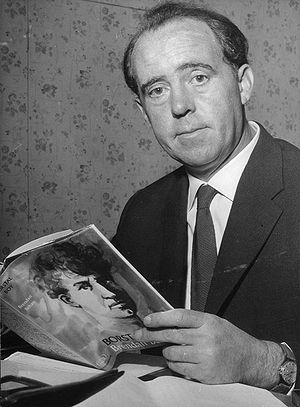
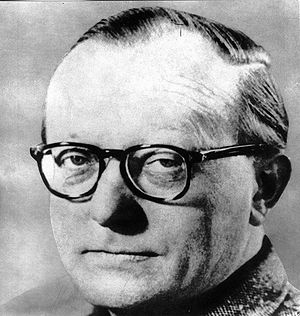
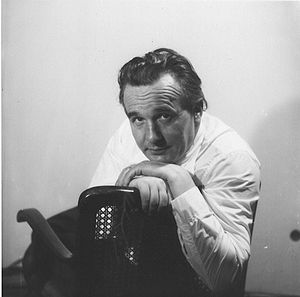
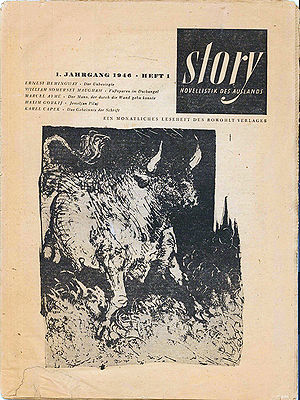
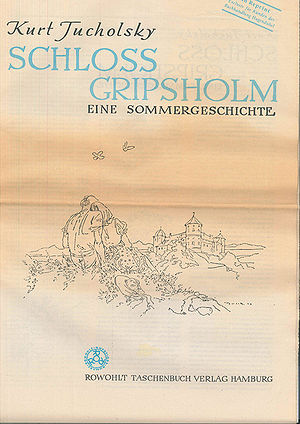
The term "Trümmerliteratur" ("rubble literature", also known as war/returnee literature, "Kahlschlagliteratur" [clear-cutting literature] or "Literatur der Stunde Null" [zero hour literature]) describes a German literary epoch. The authors are influenced by the experience of returning from war or immediate post-war society. In their works, they portray as realistic a picture as possible of the post-war world and their war experiences.
Introduction
The term "Trümmerliteratur" ("rubble literature", also known as war/returnee literature, "Kahlschlagliteratur" [clear-cutting literature] or "Literatur der Stunde Null" [zero hour literature]) describes a German literary epoch that spanned a relatively short period of time (1945 to the beginning of the 1950s) and cannot be equated with the term "post-war literature" (period up to the mid-1960s). The "Trümmerliteratur" authors had often returned from the war themselves or were observers of this process. The term reflects what they found when they returned home, namely rubble – both external (ruins) and internal (mental condition, destroyed ideals and values). The critics of this literary creation used the term "Trümmerliteratur" in a derogatory sense. The "Trümmerliteratur" authors endeavoured to paint as realistic a picture of the post-war world as possible, and to describe their experiences in the war. This was also reflected in their language, which was kept simple and freed from the ideological influence of the Nazi era. As the language of prose was considered by many to have been denigrated by the Nazi era, numerous lyrical and epic works, especially short stories, sonnets, and satires, were produced. The writers thus consciously differentiated their work from previous literary epochs. Notable authors include Heinrich Böll (1917-1985), Wolfgang Borchert (1921-1947), Wolfgang Koeppen (actually Wolfgang Köppen, 1906-1996) and Günter Eich (1907-1972). Gruppe 47 (Group 47) is significant for the period’s literary creations. As the reconstruction of cities progressed and the events of the war became more distant, and as some "Trümmerliteratur" authors distanced themselves from their own works, it increasingly receded into the background in the 1950s.
Term
Among the literary genres that sort texts according to poetic motifs (e.g. moon poems, war novels, etc.), rubble literature has a special position: historically, the term is limited to a very short phase. It is of a more polemical-programmatic than descriptive nature and is therefore probably missing from relevant literary lexicons. However, parallel terms such as "Trümmerfilm" (rubble film), “Trümmerästhetik” (rubble aesthetics), "Trümmerzeit" (rubble era) (this was the subject of a major exhibition in Munich in 1984!) and "Trümmerlyrik" (rubble poetry) prove its relevance. The term “Trümmerfrauen“ (rubble women) is used in an extra-literary context.
Representatives and content focus
The Trümmerliteratur authors' texts are directed against the language and literature of books written before 1945, including the literature of the 1920s: it was denounced as "calligraphy" – "a purely aesthetic word-form art" – by Gustav Rene Hocke (1908-1985) in the Munich-based magazine Der Ruf (The Call, November 1946). "One sees things as they are and openly describes what one finds at the edge of the paths and ruins without any arabesques," describes Hocke. In the philologist's review, the new language is "an idealised colloquial and everyday language, which is characterised by stylistic features: parataxis, speaking style, ellipses, inversion, successive precision and anacoluthon" (t + k – volume on Gruppe 47, p 81).
Infused with experiences from the war, May 1945 was seen as the so-called zero hour, and there was added belief in the possibility of a totally new beginning after the years of "slave language". The writers relied on a "true, realistically succinct means of expression," a writing style of mere description. Although "speaking naked" can certainly be understood as “an antithesis to lyric poetry” (Geschichte der deutschen Literatur von 1945 bis zur Gegenwart, pub. W. Barner, 77), a much-quoted poem is considered to be t h e canonical text of rubble literature in its laconicism, simple choice of words and word repetitions: Günter Eich's "Inventur" (Inventory), which first appeared in the "Deine Söhne, Europa. Gedichte deutscher Kriegsgefangener" (Your Sons, Europe. Poems by German Prisoners Of War) anthology by Hans Werner Richter (1908-1993) published in 1947. Just as the military rank of the authors was often specified in corresponding works before 1945, the respective prison camps across Europe and the USA in which the authors had been held were specified here. Eich's poem lists the remains of his property as a prisoner in seven unrhymed rhythmic quatrains. The opening verses read:
| "Dies ist meine Mütze, | "This is my cap, | |||
| dies ist mein Mantel, | this is my overcoat, | |||
| hier mein Rasierzeug | this is my shave kit | |||
| im Beutel aus Leinen. | in its linen pouch. | |||
| Konservenbüchse: | Some field rations: | |||
| Mein Teller, mein Becher, | my dish, my tumbler, | |||
| ich hab in das Weißblech | here in the tin-plate | |||
| den Namen geritzt." | I've scratched my name." |
The most important programmatic explanation of the term was provided, only too late, apparently, by Heinrich Böll (1917-1985) in his "Bekenntnis zur Trümmerliteratur" (Avowal to Rubble Literature, published in May 1952 in Die Literatur [The Literature]). Böll places the term synonymously next to war and returnee literature and fends off objections to rubble as a literary motif by referring to Homer‘s epics, which also had been "war, rubble and returnee literature" already. At the same time, he argues:
- Against a taste of escapism in literature: Literature should not carry the reader off into an idyll, it should, in the words of Hans Werner Richter, be devoted "to the external image of that landscape whose profile is marked by the ruins and rubble of the great cities."
- Against the issue of topicality: As a result of the buildings that were rebuilt as early as 1952 at the start of the economic miracle, the rubble only appears to be losing its significance; in the new buildings, Böll sees, first and foremost, administrative edifices that hardly help the people's plight at all. The "destructions in our world are not just external and not so minor in nature that one can presume to heal them in a few years." Hans Werner Richter once again: "The moral, spiritual and ethical pile of rubble left behind [for a new generation] by a truly lost generation is growing immeasurably and appears greater than that which is actually visible."
In other words, "Trümmerliteratur" radiated far into the 1950s, although no longer with the usual rigour; Böll's "Irisches Tagebuch" (Irish Journal), which belongs to travel literature (travel literature being an important form of rubble literature), was published in 1957.
In retrospect, Wolfgang Frühwald (born 1935), questioned the literary validity and quality of the "genre”, citing audience statistics and functioning as a critical authority (in: Friedrich Prinz [pub.], Trümmerzeit in München, Munich 1984). However, this kind of devaluation not only fails to acknowledge the historical-testimonial value of this short-lived genus, but also the continuing interest in it: Eich's poems and Böll's "stories of the rubble" still have a place in the literary canon. According to Ludwig Fischer's representative literary history, Böll became a "classic storyteller and textbook author".The rubble literature works have asserted themselves as documents of engaged literature against the initial aversion to war memories and changing tastes.
In addition, few phenomena arouse as much literary sociological interest as Gruppe 47, which was founded in Bavaria and usually met there, and to which the majority of the rubble literature authors belonged: they were, as can be read in the special text + kritik issue on Gruppe 47, "with few exceptions literary novices and had yet to find their individual style. The start was made more difficult by the necessity to purify language, by the belief that it was necessary to start without any preconditions."
The "disregard for the narrative novel" (Walter Jens), which has been ascertained in writers of rubble literature and is reflected in the wealth of travelogues published at the time – facts instead of fiction – made short stories, partly modelled on the archetype of the short story by Hemingway and others, and poems become the most frequently represented types of poetry in rubble literature. Also applicable to these two genres is Wolfgang Weyrauch‘s (1904-1980) programmatic epilogue to the representative collection with the period-typical, laconic title : "Tausend Gramm. Sammlung neuer deutscher Geschichten" (A thousand grams. Collection of new German Stories, 1949), reprinted in 1989 with the subtitle "Ein deutsches Bekenntnis aus dem Jahr 1949" (A German Confession from 1949) and a list of the most important names: "Alfred Andersch, Marieluise Fleißer, Walter Kolbenhoff, Ernst Kreuder, Luise Rinser, Gustav Schenk, Ernst Schnabel, Günther Weisenborn and others".
References
- Georg Böhringer, Die Zeitschriften-Landschaft in München 1945-1949, in: Friedrich Prinz (Hg.), Trümmerzeit in München. Kultur und Gesellschaft einer deutschen Großstadt im Aufbruch 1945-1949, München 1984, 261-268 und 439-444. (mit Verzeichnis)
- Hansjörg Gehring, Amerikanische Literaturpolitik in Deutschland 1945-1953. Ein Aspekt des Re-Education-Programms (Schriftenreihe der Vierteljahrshefte für Zeitgeschichte 32), Stuttgart 1976.
- Gerhard Hay, Literarische Positionen im München der Nachkriegszeit, in: Friedrich Prinz (Hg.), Trümmerzeit in München. Kultur und Gesellschaft einer deutschen Großstadt im Aufbruch 1945-1949, München 1984, 209-219.
- Jost Hermand (Hg.), Nachkriegsliteratur in Westdeutschland 1945-49. 2 Bände (Literatur im historischen Prozeß), Berlin 1982/1983.
- Dieter Hoffmann, Arbeitsbuch Deutschsprachige Prosa seit 1945. 2 Bände, Tübingen/Basel 2006.
- Ingrid Laurien, Politisch-kulturelle Zeitschriften in den Westzonen 1945-1949. Ein Beitrag zur politischen Kultur der Nachkriegszeit (Europäische Hochschulschriften 3/502), Frankfurt am Main u .a. 1991. [Diss, Grebing, Göttingen]
- Anke-Marie Lohmeier, Zeitschriftenkultur in den Westzonen zwischen Kriegsende und Währungsreform, in: Günter Häntzschel (Hg.), Neue Perspektiven der deutschen Buchkultur in den 50er Jahren des 20. Jahrhunderts. Ein Symposion, Wiesbaden 2003, 13-28.
- Irmela von der Lühe, Verdrängung und Konfrontation - die Nachkriegsliteratur, in: Peter Reichel/Harald Schmid/Peter Steinbach (Hg.), Der Nationalsozialismus - Die zweite Geschichte. Überwindung - Deutung - Erinnerung, München 2009, 243-260.
- Ernestine Schlant, Die Sprache des Schweigens. Die deutsche Literatur und der Holocaust, München 2001.
- Ralf Schnell, Geschichte der deutschsprachigen Literatur seit 1945, Stuttgart/Weimar 2., überarbeitete und erweiterte Auflage 2003.
- Alfons Schweiggert/Hannes S. Macher (Hg.), Autoren und Autorinnen in Bayern. 20. Jahrhundert, Dachau 2004.
- Volker Wehdeking, Anfänge westeutscher Nachkriegsliteratur. Aufsätze, Interviews, Materialien (Rader Publikationen), Aachen 1989.
- Reinhard Wittmann, Auf geflickten Straßen. Literarischer Neubeginn in München 1945 bis 1949 (Monakzente 2), München 1995.
External Links
Further Research
Kahlschlagliteratur Kriegsliteratur Heimkehrerliteratur Literatur der Stunde Null
Cite
Ulrich Dittmann, Trümmerliteratur (rubble literature), published 03 May 2016, English version published 24 March 2024; in: Historisches Lexikon Bayerns, URL: <https://www.historisches-lexikon-bayerns.de/Lexikon/EN:Trümmerliteratur_(rubble_literature)> (21.12.2025)
